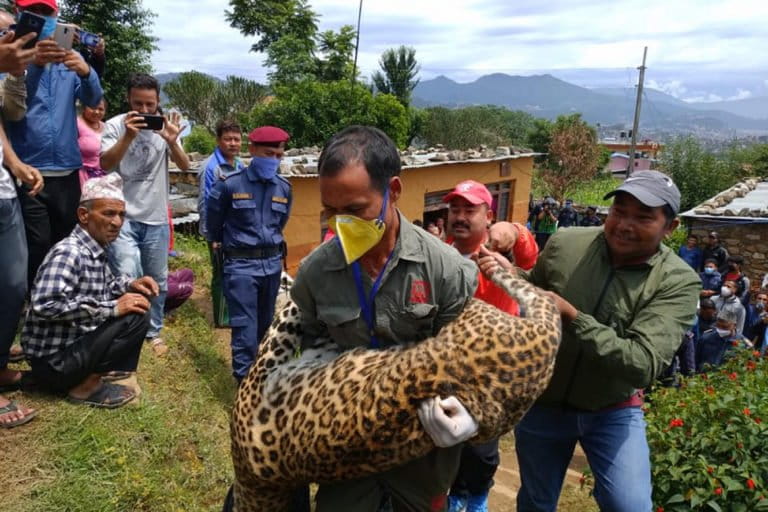- A new study shows for the first time that leopards in Nepal are exposed to canine distemper virus.
- Researchers suggest the virus could make the big cats less fearful of humans and thus more likely enter settlements in search of food.
- Conservationists have long warned of the risk of feral dogs passing on diseases like canine distemper to wildlife in Nepal, including tigers and leopards.
- Other studies show that while initial infections may have come from dogs, multiple strains the virus are now circulating among wildlife, making the latter carriers too.
KATHMANDU — On Nov. 1 last year, a leopard dragged off an 8-year-old boy as he was playing just steps away from the cowshed where his grandmother was milking the family’s cow. The boy was later discovered dead.
Following the incident in Tanahun district, in central Nepal, the local administration authorized security forces to shoot the leopard, believing it was to blame for the deaths of five of the 14 children killed by leopards in the past five years. On Dec. 5, security personnel gunned down a 50-kilogram (110-pound) leopard in Tanahun, and said it was the animal they’d been looking for.
Nepal’s central foothills have long been a hotspot of human-leopard conflict, which experts attribute to a lack of wild prey, water and habitat for leopards (Panthera pardus). However, as a new study suggests that there maybe a high prevalence of a disease in the leopard population in the area that can affect their nervous system, conservationists suspect that this could have a role to play in increased human-leopard conflict.
“We found that most of the leopards from Tanahun we tested during the course of our study showed signs of antibodies against the canine distemper virus,” or CDV, said Dr. Amir Sadaula, a wildlife veterinarian and co-author of the study published in the journal Pathogens. “This means that they were exposed to the virus, which is known to make leopards weak and search for easy prey.”

CDV is closely related to the measles virus in humans. Animals infected with the highly contagious disease have been observed to develop fever, become unresponsive, and refuse to eat or drink. Other symptoms include coughing and discharges from the eyes and nose; vomiting and diarrhea; and involuntary muscular twitching, posterior paralysis, or convulsions.
The virus and its disease caught the attention of wildlife conservationists in 1994, when nearly a third of the lions (Panthera leo) in Tanzania’s Serengeti National Park were found to have died from an outbreak of the virus. Previously, CDV was only believed to infect canids like dogs and wolves, not felids like lions and leopards.
As part of the study, Sadaula, from Nepal’s National Trust for Nature Conservation (NTNC), and his team focused on leopards and tigers (Panthera tigris) in and around the Chitwan-Annapurna landscape. The team analyzed blood samples taken from 28 tigers and 20 leopards that were captured as part of routine work; whenever vets at Chitwan National Park receive a call from local communities to rescue tigers or leopards involved in conflict, they take blood samples from the animals before releasing them, and store the samples for future studies.
According to the study, six leopards and three tigers were found to have developed antibodies against CDV, marking the first known exposure of these big cats to the virus in Nepal.

“We had previously carried out a study to look at the prevalence of a panel of diseases, including canine distemper in tigers back between 2011 and 2017,” Sadaula told Mongabay. “But we hadn’t found CDV antibodies in tigers. This is the first time we analyzed sera from leopards.”
Two of the leopards that had developed antibodies died, while four others were released into the wild. The leopards that died were both unresponsive.
The first one was exceptionally thin and refused to eat, while the other showed signs of hind limb paralysis and muscle wastage. The skin of the foot pads was dark and thickened, both of which are well-recognized symptoms in CDV-infected dogs. However, one of the leopards that had developed antibodies to CDV responded well to treatment with antibiotics and made a full recovery.
One tiger that showed clinical signs of the infection and was reported to be thin but “unusually confident” also died.
“In its acute phase, CDV infects an animal’s nervous system. By then, recovery is unlikely without aggressive intervention,” said wildlife disease ecologist Debby Ng, who has studied the prevalence of the virus among dogs in the Annapurna region.
“It is not surprising that leopards that come into conflict with people are CDV positive as the pathogen is prevalent in urban areas with domestic dogs,” she added. (Editor’s note: Debby Ng is a member of Mongabay’s board.)

The authors also went back to their records to look at reported leopard and tiger deaths in the area between September 2019 and September 2022. They came across five more leopard death cases, where blood samples hadn’t been collected, with symptoms matching those of CDV. In all the cases, the animal had developed fatal seizures, which could also be attributed to parasitic disease, neoplasia, intoxication, head trauma, rabies, meningitis, metabolic encephalopathies, hypoglycemia and epilepsy.
Study co-author Martin Gilbert, an associate professor at the College of Veterinary Medicine at Cornell University, U.S., said the results are relatively more worrisome for leopards than tigers.
“We have seen images and photos of leopards in human settlements that are unusually not afraid of people and even not attacking them when they are near,” Gilbert said, adding that these could be signs that the leopards have been infected with CDV.
That CDV infections seem to be more prevalent in leopards than tigers could be attributed to the fact that leopards are known to prey on feral dogs, considered one of the chief sources of the virus, while tigers rarely prey on dogs.
Feral dogs are the usual suspects when it comes to the issue of canine distemper virus in Nepal. In a soon-to-be-published study, researchers tested 163 dogs in the buffer zone of Chitwan National Park, looking for antibodies associated with canine distemper virus. They found that 17% were infected with CDV. Another study, led by Ng, found a high prevalence of canine distemper antibodies in dogs from villages in Nepal’s Annapurna Conservation Area. Various community-led initiatives have also been launched to vaccinate dogs against the disease.
For years following the mass lion deaths in the Serengeti, conservationists worldwide believed the virus may have transmitted from domesticated dogs. However, a 2015 study uncovered evidence suggesting transmission from other unknown carriers, such as hyenas. When researchers compared antibody data from the lions and the dogs, they found while that the initial wave of infections in lions may have come from dogs, later spikes came from elsewhere.

In Nepal, too, the virus may be circulating among the wild species, and feral dogs may not be the only source of infection, Gilbert said.
The study notes that findings by researchers in India also suggest the same. As part of the Indian study, researchers there carried out real-time PCR tests to detect the virus in a range of wild cats, including tigers and leopards, in Uttar Pradesh state, bordering Nepal. What they found pointed to “multiple strains circulating amongst wildlife close to Nepal, and there may even be multiple cycles involving different species,” Saudala’s study said.
Sadaula said the main takeaway from the study is that there needs to be regular monitoring of the virus and the different strains circulating in different populations.
“We now need to sequence the virus found in dogs, tigers and leopards and see if they are coming from the same source,” he said. “Then we can take measures to control its spread.”
Banner Image: A common leopard photographed in India. Image by Srikaanth Sekar via Flickr (CC BY-SA 2.0).
The original version of this article stated that the study by Dr Sadaula, Gilbert and team published in the journal Pathogens suggests a link between cases of human-leopard conflict and the prevalence of canine distemper virus. It has now been corrected and we regret the error.
Feedback: Use this form to send a message to the author of this post. If you want to post a public comment, you can do that at the bottom of the page
Abhaya Raj Joshi is a staff writer for Nepal at Mongabay. Find him on Twitter @arj272.
Citations:
Bodgener, J., Sadaula, A., Thapa, P. J., Shrestha, B. K., Gairhe, K. P., Subedi, S., . . . Gilbert, M. (2023). Canine distemper virus in tigers (Panthera tigris) and leopards (P. pardus) in Nepal. Pathogens, 12(2), 203. doi:10.3390/pathogens12020203
McCauley, D., Stout, V., Gairhe, K. P., Sadaula, A., Dubovi, E., Subedi, S., & Kaufman, G. E. (2021). Serologic survey of selected pathogens in free-ranging Bengal tigers (Panthera tigris tigris) in Nepal. Journal of Wildlife Diseases, 57(2). doi:10.7589/jwd-d-20-00046
Ng, D., Carver, S., Gotame, M., Karmasharya, D., Karmacharya, D., Man Pradhan, S., … Johnson, C. N. (2019). Canine distemper in Nepal’s Annapurna Conservation Area — Implications of dog husbandry and human behaviour for wildlife disease. PLOS ONE, 14(12), e0220874. doi:10.1371/journal.pone.0220874
Viana, M., Cleaveland, S., Matthiopoulos, J., Halliday, J., Packer, C., Craft, M. E., … Lembo, T. (2015). Dynamics of a morbillivirus at the domestic–wildlife interface: Canine distemper virus in domestic dogs and lions. Proceedings of the National Academy of Sciences, 112(5), 1464-1469. doi:10.1073/pnas.1411623112
Kadam, R. G., Karikalan, M., Siddappa, C. M., Mahendran, K., Srivastava, G., Rajak, K., … Sharma, A. (2022). Molecular and pathological screening of canine distemper virus in Asiatic lions, tigers, leopards, snow leopards, clouded leopards, leopard cats, jungle cats, civet cats, fishing cat, and jaguar of different states, India. Infection, Genetics and Evolution, 98, 105211. doi:10.1016/j.meegid.2022.105211
